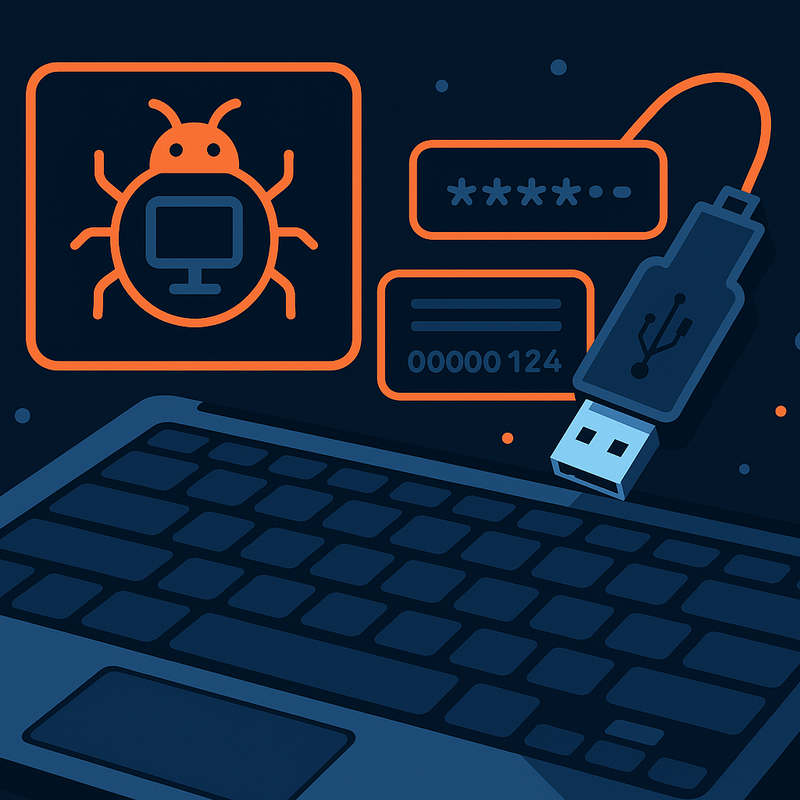Shark Jack by Hak5 is a discreet tool that looks like a small USB Ethernet adapter, but its capabilities go far beyond any ordinary device. It is designed primarily for penetration testers, network administrators, and IT specialists who need to quickly perform security tests or automate repetitive network tasks. Shark Jack is ideal not only for quick network reconnaissance, but also for data exfiltration or automated attacks within internal networks—all triggered by a simple flip of a switch. The device comes in two variants: the original Shark Jack with a battery, and the Shark Jack Cable powered via USB-C. The battery version runs for about 10–15 minutes on a single charge, making it perfect for short audits directly in the field or during social engineering engagements. The Cable variant is intended for longer or permanent deployment—just plug it in for power and the device can run without limitation. Operating the Shark Jack is very simple. With a small switch, you choose between...
Blog
List of articles
WiFi Pineapple by Hak5 is a legendary tool that at first glance resembles an ordinary router, but in reality, it is an extremely powerful platform for testing the security of wireless networks. It is designed mainly for penetration testers, network administrators, and security enthusiasts who want to analyze, monitor, or even "lure" clients into fake networks and test their resilience to attacks. The latest generation, Mark VII, takes the possibilities even further—it offers an intuitive web interface, a large library of modules, and the option of remote management via the cloud. The basic principle of WiFi Pineapple is simple: it creates its own wireless networks (including “rogue” or “evil twin” APs) that nearby devices can connect to. It can thoroughly analyze the surrounding WiFi traffic, collect information about clients, capture handshakes, filter devices by MAC addresses or SSIDs, and automate a whole range of attacks—for example, WiFi phishing, DNS spoofing, MITM attacks, or s...
USB Rubber Ducky by Hak5 is a device that looks like an ordinary USB flash drive, but inside it hides the power of a top-tier scripting tool for automated attacks and penetration testing. The basic principle is simple—once plugged in, the Ducky identifies itself as a USB keyboard and can “type” almost any command, key sequence, or macro into the computer within seconds. This technique, known as keystroke injection, is what makes the Ducky an indispensable tool for every pentester, IT administrator, and security enthusiast. What makes Rubber Ducky unique is its own language, Ducky Script, which in its latest version 3.0 allows not only sequential key entry, but also conditions, loops, variables, functions, and even the use of random data or more advanced HID and storage attacks. Even beginners can handle Ducky Script—simple payloads can be written in minutes, while advanced scripts allow for complex attacks, data exfiltration, LED control on the device, or interaction with the user via...
Screen Crab by Hak5 is a discreet HDMI adapter that serves as a spy “man-in-the-middle” device for screen capturing. At first glance, it looks like an ordinary HDMI extension, but in reality, it allows you to quietly capture screenshots or video recordings between any HDMI input and output—for example, between a computer and monitor, a console and television, or even between a presentation laptop and a projector. Using the Screen Crab is extremely simple and requires no complicated configuration. Just connect it with two HDMI cables between the source and output device, insert a microSD card (FAT32 or exFAT), and power it using a USB-C cable. After a short boot-up, the Screen Crab will automatically start saving screenshots to the microSD card at regular intervals. The LED indicator shows that capturing is in progress—blue means image capture, yellow is for video recording, and white signals no video input. To safely eject the card, simply press the button and wait for the green light...
Packet Squirrel by Hak5 is a discreet network “multi-tool” that looks like a regular Ethernet adapter but hides powerful features for network administrators, penetration testers, and security enthusiasts. It is designed primarily for discreet network traffic capture, covert remote access, automated network attacks, and fast VPN connections—all with just the flip of a small mechanical switch on the bottom of the device. Using the Packet Squirrel is very simple. You just plug it in between the target device (such as a computer, printer, or IP phone) and the rest of the network using two Ethernet cables. Power is supplied via a standard USB-C cable, making it easy to hide or even run the device from a power bank. On first boot, it automatically initializes, and within a few minutes, it is ready to use. Configuration and management are handled via a web interface or SSH, which you access through the special “Target port.” The initial setup consists only of setting a password and time zone...
LAN Turtle by Hak5 is a discreet USB Ethernet adapter that at first glance looks like an ordinary network card. In reality, however, it is one of the most versatile tools for remote access and man-in-the-middle attacks, intended mainly for penetration testers and network administrators. When plugged into a USB port, the device is recognized as a network adapter, but its real power lies in its ability to provide hidden remote access to the network, collect sensitive data, or monitor and manipulate traffic between the computer and the rest of the network. This makes it possible to efficiently—and often stealthily—test the security of both enterprise and home networks. Managing the LAN Turtle is based on a simple text menu called the Turtle Shell, accessible via SSH. With Turtle Shell, you can easily set network parameters, update firmware, change passwords, or manage individual modules. Each module represents a specific function—for example, remote shell, VPN connection, man-in-the-midd...
Key Croc by Hak5 is a discreet USB device that at first glance looks like an ordinary adapter between a keyboard and a computer, but in reality, it is a state-of-the-art keylogger and next-generation pentesting tool. Once inserted between the keyboard and the computer, Key Croc can quietly record every keystroke while remaining fully pass-through — the user usually won’t notice anything. What’s even more interesting is that Key Croc can react to specific keystroke sequences (so-called pattern matching), so after a particular text or password is typed, it automatically executes a pre-configured script. This is what sets Key Croc apart from regular keyloggers—it’s not just a passive “listener,” but an active part of a pentesting attack. Operating the Key Croc is designed to be very simple. As soon as you plug the device between the computer and the keyboard, it immediately starts logging all keystrokes in its default mode. If you want to manage the device, all you need to do is press th...
Bash Bunny by Hak5 is a discreet yet very powerful device that looks like a regular USB flash drive but can do much more. Once connected to a computer, Bash Bunny can emulate various types of USB devices, such as a keyboard, network adapter, or storage. Thanks to this, it is possible to automatically launch pre-prepared attacks, extract data from the target computer, install backdoors, or bypass security measures in just a few seconds. Bash Bunny is therefore mainly suited for penetration testing, security audits, or even for automating routine IT tasks that would otherwise take hours of manual work. Using the Bash Bunny is simple and intuitive. The device has a small switch that lets you select one of three modes. The position closest to the USB connector is called “arming mode,” in which the Bash Bunny connects as a storage device and serial console. In this mode, you can easily upload new scripts, configure the device, or access stored attack results. The other two positions are in...
A keylogger is software or hardware designed to record every keystroke on a computer keyboard. These tools can be misused to steal sensitive information such as passwords, credit card numbers, or personal data, often without the user’s knowledge. Types of keyloggers There are two main categories of keyloggers: software-based and hardware-based. Software keyloggers are programs that run in the background of an operating system, monitoring and recording keystrokes. They are often part of malware or spyware and can spread via infected emails or malicious websites. Hardware keyloggers are physical devices connected between the keyboard and the computer that log keystrokes. These devices are typically inconspicuous and hard to detect because they do not require software installation and are not picked up by standard antivirus programs. Keylogger distribution methods Keyloggers can enter a system in various ways. They most commonly spread through phishing emails, malicious websites, or...
The Hidden Impact of Late-Night Phone Use Most people can’t imagine their evenings without scrolling through their phone before bed, but this habit may be doing more harm than good. Late-night phone use interferes with sleep quality, making it harder to fall and stay asleep. The blue light emitted from screens disrupts melatonin production, tricking the brain into thinking it’s still daytime. This throws off the body’s natural sleep cycle, leading to restless nights and sluggish mornings. Why Your Phone Keeps You Awake Beyond blue light exposure, the dopamine-driven nature of smartphones keeps the brain alert when it should be winding down. Scrolling through social media, reading emails, or playing games stimulates the brain, delaying the natural transition to sleep. Even when phones are set to ‘Do Not Disturb,’ the subconscious habit of checking for notifications can keep users from fully relaxing. Why Software Adjustments Aren’t Enough Many people try to mitigate these effects b...
In today’s digital age, cars have evolved from simple mechanical machines into highly sophisticated computers on wheels. With the increasing reliance on electronic systems and wireless technology, car hacking has transitioned from science fiction into a real and growing threat. Car hacking refers to the exploitation of vulnerabilities in a vehicle’s electronic systems to gain unauthorized access or control. What once seemed like a movie plot has now become a serious concern for car owners worldwide. The Growing Threat: Understanding the Numbers Recent statistics reveal the alarming rise of car hacking incidents: • Between 2018 and 2019, automotive hacking incidents in the U.S. increased by 138%, proving that this is no minor concern—it’s an evolving cyber threat (Motor Illustrated). • In 2021, car cyberattacks surged by 225% compared to 2018, and shockingly, 85% of these attacks were conducted remotely (ISRAEL21c). These numbers illustrate a clear reality—car hacking is not just...
Traveling abroad is an exciting opportunity to explore new places and cultures. However, one of the most critical items you carry is your passport, which contains sensitive personal data. If lost or stolen, your passport could be used for identity theft and fraud. This article explains what makes your passport a high-value target, the risks of compromised passport data, real-world cases of passport-related theft, and effective ways to protect it. What’s Inside Your Passport? Your passport is more than just a travel document—it contains: • Full legal name • Date and place of birth • Passport number • Issuing country and expiration date • Biometric data • Physical description (height, hair, and eye color) • Digital photograph • RFID chip with encrypted personal data Because all this information is stored in one place, a passport is a prime target for identity theft. The RFID chip, in particular, can be vulnerable to unauthorized access by attackers using specialized scanning...
The Faraday cage, named after the English physicist Michael Faraday, was introduced in of the previous articles. It is a device designed to protect people or equipment from electric fields. It uses an enclosed metal structure that blocks the electric field and prevents it from affecting objects inside the cage. The Faraday cage is used in many areas of science, technology and everyday life. Some examples of applications will be given in the following paragraphs. Protection of electronics against electromagnetic radiation Nowadays, when data transmissions and sensitive electronics are increasingly vulnerable to electromagnetic fields, the Faraday cage is commonly used to protect electronic devices. For example, special rooms equipped with Faraday cages are used in laboratories and research facilities to protect electronics from interfering signals. These cages are often made of copper or aluminium mesh and are designed to prevent electromagnetic interference, which is particularly imp...
NFC (Near Field Communication) and RFID (Radio-Frequency Identification) technologies have become an integral part of our daily lives. These technologies allow us to make contactless payments, access services or transfer data conveniently and quickly. However, with their growing popularity come new threats such as NFC and RFID skimming, methods that attackers use to steal data in your vicinity. What is NFC and RFID skimming? NFC skimming is a form of data theft in which an attacker uses NFC technology to steal information from your devices, such as credit cards or smartphones. NFC works over a very short distance, usually within a few centimetres, which allows attackers to stealthily approach close to you and capture data without your knowledge. How does NFC and RFID skimming work? Unlike other types of skimming, NFC/RFID skimming does not require extensive technical knowledge and the attacker can even make do with his mobile phone if it has an NFC/RFID reader. The reader can also ...
Cybersecurity is a key issue for companies and individuals today. With the growing threats in the digital world, it is important to always stay one step ahead of potential attackers. One way to achieve this is by regularly conducting penetration testing. But what exactly is penetration testing and why is it so important? What is penetration testing? Penetration testing, often abbreviated as pentest, is a simulated cyber attack on a system, application or network to identify vulnerabilities that could be exploited by real attackers. The testing is conducted by cybersecurity experts who attempt to penetrate the system using the same methods that hackers might use. That's why these experts are also called ethical hackers. Their goal is not to cause harm, but to expose vulnerabilities before someone with malicious intent discovers them. Penetration testing can include different types of attacks such as: Network attacks: Testing for weaknesses in network infrastructure such as fi...
Among the most common questions we answer is definitely the most basic question - what is the Faraday bag suitable for and what situations should it be used in? Not only on our e-shop, you will find a lot of information about Faraday bags being suitable for law enforcement officers who primarily need to ensure that essential data is not deleted when transporting devices of interest. However, this is not the only use, and the Faraday bag is also suitable for the average user who likes to protect their privacy. We have therefore decided to describe some situations in this article. We certainly don't need to remind you that nowadays electronic devices are an indispensable part of our every day and due to frequent interactions, we store very sensitive personal and professional information on them. This is, of course, very convenient, but only until our sensitive data is illegally obtained or altered. And that you have nothing to hide? You don't want anyone to be able to look through famil...
In today's technologically advanced world, we face many challenges regarding electromagnetic interference and the protection of sensitive electronic equipment. One of the most important and effective tools to protect against these problems is the Faraday cage. This article will focus on the principles, history and modern applications of the Faraday cage. What is a Faraday cage? A Faraday cage is a device designed to block the electromagnetic field. It is named after the British scientist Michael Faraday, who was introduced in our previous article. The cage is made up of a conductive material that surrounds a certain space and protects it from external electromagnetic fields. Its principle is based on the fact that electric charges redistribute across the surface of the conductor, creating an opposing field that cancels out external electromagnetic effects inside the cage. The history of the Faraday cage Michael Faraday, the eminent 19th century physicist and chemist, discover...
Michael Faraday is one of the outstanding scientists of the 19th century, whose work fundamentally influenced the development of modern physics and chemistry. Although he had no formal education in the field, his enthusiasm, curiosity and determination led him to make discoveries that laid the foundation for many of the technologies we encounter every day. Early life and the path to science Faraday was born on 22 September 1791 in Newington Butts, an area that is nowadays a part of London. His family was poor and Faraday could not devote himself to education, as he had to work from the age of thirteen. He was apprenticed to a bookbinder with his employer and through his work he had access to many books which he read and studied with great interest. He was particularly fascinated by science, which led him to attend the lectures of the famous chemist Humphry Davy, with whom he later worked as an laboratory assistant. He also accompanied him on scientific trips around Europe, where he c...














-1.jpg)
-1.jpg)

-1.jpg)
.jpg)








